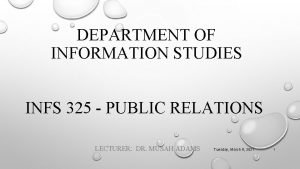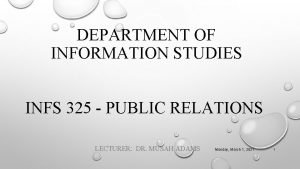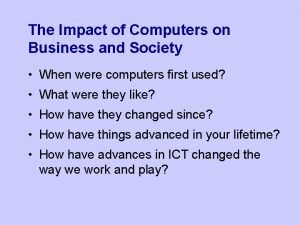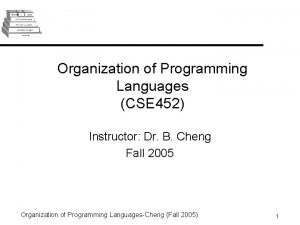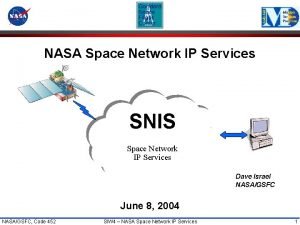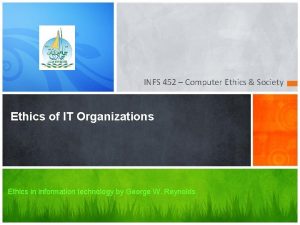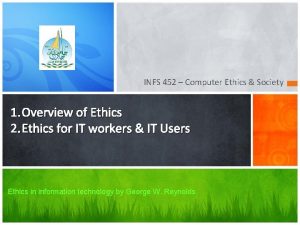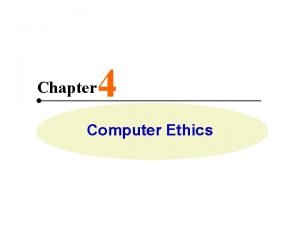INFS 452 Computer Ethics Society THE IMPACT OF














- Slides: 14

INFS 452 – Computer Ethics & Society THE IMPACT OF INFORMATION TECHNOLOGY ON PRODUCTIVITY AND QUALITY OF LIFE Ethics in information technology by George W. Reynolds

INTRODUCTION AND OVERVIEW • The standard of living varies greatly among groups within a country as well as from nation to nation. • The most widely used measurement of the material standard of living is gross domestic product (GDP) per capita. • National GDP represents the total annual output of a nation’s economy. • Overall, industrialized nations tend to have a higher standard of living than developing countries.

IT Investment and Productivity • Productivity is defined as the amount of output produced per unit of input, and it is measured in many different ways. • Innovation is a key factor in productivity improvement, and IT has played an important role in enabling innovation. • In the early days of IT in the 1960 s, productivity improvements were easy to measure. • Today, organizations are trying to further improve IT systems and business processes that have already gone through several rounds of improvement.

Tele-work • Tele-work (also known as telecommuting) is a work arrangement in which an employee works away from the office—at home, at a client’s office, in a hotel— literally, anywhere. • In Tele-work, an employee uses various forms of electronic communication, including e-mail, audio conferencing, video conferencing, and instant messaging.

Continued….

Continued….

The Digital Divide • Another indicator of the standard of living is the availability of technology. • The digital divide is a term used to describe the gulf between those who do and those who don’t have access to modern information and communications technology such as cell phones, personal computers, and the Internet. • The digital divide exists not only between more and less developed countries but also within countries—among age groups, economic classes, and people who live in cities versus those in rural areas.

E-Rate Program • The Education Rate (E-Rate) program was created through the Telecommunications Act of 1996. • One of E-Rate’s goals is to help schools and libraries obtain access to state-of-the-art services and technologies at discounted rates. • The program’s discounts range from 20 percent to 90 percent for eligible telecommunications services, depending on location (urban or rural) and economic need.

THE IMPACT OF IT ON HEALTHCARE COSTS • The development and use of new medical technology, such as new diagnostic procedures and treatments (see Figure 8 -2 in book), has increased spending and “accounts for one-half to two-thirds of the increase in healthcare spending in excess of general inflation. ” • Although many new diagnostic procedures and treatments are at least moderately more effective than their older counterparts, they are also more costly. • To really gain control over soaring healthcare costs, patient awareness must be raised and technology costs must be managed more carefully.

Electronic Health Records • An electronic health record (EHR) is a summary of health information generated by each patient encounter in any healthcare delivery setting. • An EHR includes patient demographics, medical history, immunization records, laboratory data, problems, progress notes, medications, vital signs, and radiology reports. • EHRs could incorporate data from any healthcare entity a patient uses and make the data easily accessible to other healthcare professionals. • Healthcare professionals can use an EHR to generate a complete electronic record of a clinical patient encounter.

Use of Mobile and Wireless Technology in the Healthcare Industry • The healthcare industry was actually a leader in adopting mobile and wireless technology. • Common uses of wireless technology in the healthcare field include: – Providing a means to access and update EHRs at patients’ bedsides to ensure accurate and current patient data – Enabling nurses to scan bar codes on patient wristbands and on medications to help them administer the right drug in the proper dosage at the correct time of day (an attached computer on a nearby cart is linked via a wireless network to a database containing physician medication orders) – Using wireless devices to communicate with healthcare employees wherever they may be

Telemedicine • Telemedicine employs modern telecommunications and information technologies to provide medical care to people who live far away from healthcare providers. • There are two basic forms of telemedicine: store-and-forward and live. – Store-and-forward telemedicine involves acquiring data, sound, images, and video from a patient and then transmitting everything to a medical specialist for later evaluation. – Live telemedicine requires the presence of patients and healthcare providers at the same time and often involves a video conference link between the two sites.

Medical Information Web Sites for Laypeople • Healthy people as well as those who suffer from illness need reliable information on a wide range of medical topics to learn more about healthcare services and to take more responsibility for their health. • Clearly, laypeople cannot become as informed as trained medical practitioners, but a tremendous amount of healthcare information is available via the Web. • These sites have a critical responsibility to publish current, reliable, and objective information. • Table 8 -9 provides just a small sample of Web sites that offer information on a variety of medical-related topics.

Continued….
 Infs 325
Infs 325 Semdr communication model
Semdr communication model Infs 325
Infs 325 Infs 2022
Infs 2022 Infs sponsorship code
Infs sponsorship code What is the impact of computers on business
What is the impact of computers on business Impact of globalization on society
Impact of globalization on society Impact of marketing on society
Impact of marketing on society Globalization definition
Globalization definition Find the number of moles of argon in 452 g of argon.
Find the number of moles of argon in 452 g of argon. Cse 452
Cse 452 Snis 452
Snis 452 Cse452
Cse452 Cse 452
Cse 452 649 yüzlüğe yuvarlama
649 yüzlüğe yuvarlama

